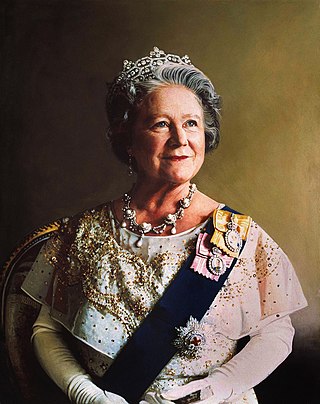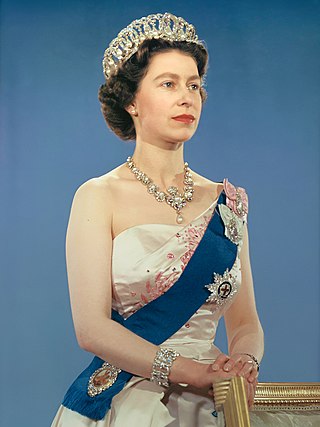
Princess Margaret, Countess of Snowdon was the younger daughter of King George VI and Queen Elizabeth The Queen Mother. She was the younger sister and only sibling of Queen Elizabeth II.

Elizabeth Angela Marguerite Bowes-Lyon was Queen of the United Kingdom and the Dominions of the British Commonwealth from 11 December 1936 to 6 February 1952 as the wife of King George VI. She was also the last Empress of India from 1936 until the British Raj was dissolved on 15 August 1947. After her husband died, she was officially known as Queen Elizabeth The Queen Mother, to avoid confusion with her daughter Queen Elizabeth II.

Mary of Teck was Queen of the United Kingdom and the British Dominions, and Empress of India, from 6 May 1910 until 20 January 1936 as the wife of King-Emperor George V.

Prince Philip, Duke of Edinburgh, was the husband of Queen Elizabeth II. As such, he was the consort of the British monarch from his wife's accession on 6 February 1952 until his death in 2021, making him the longest-serving royal consort in history.

Mountbatten-Windsor is the personal surname used by some of the male-line descendants of Queen Elizabeth II and Prince Philip, Duke of Edinburgh. Under a declaration made in Privy Council in 1960, the name Mountbatten-Windsor applies to male-line descendants of Queen Elizabeth II without royal styles and titles. Individuals with royal styles do not usually use a surname, but some descendants of the Queen with royal styles have used Mountbatten-Windsor when a surname was required.

The House of Windsor is the reigning house of the United Kingdom and the other Commonwealth realms. The house's name was inspired by the historic Windsor Castle estate. Since it was founded on 17 July 1917, there have been five British monarchs of the House of Windsor: George V, Edward VIII, George VI, Elizabeth II, and Charles III. The children and male-line descendants of Queen Elizabeth II and Prince Philip, Duke of Edinburgh, also genealogically belong to the House of Oldenburg since Philip was by birth a member of the Glücksburg branch of that house.

The Mountbatten family is a British family that originated as a branch of the German princely Battenberg family. The name was adopted by members of the Battenberg family residing in the United Kingdom on 14 July 1917, three days before the British royal family changed its name from Saxe-Coburg and Gotha to Windsor. This was due to rising anti-German sentiment among the British public during World War I. The name is a direct Anglicisation of the German name Battenberg, which refers to a small town in Hesse. The Battenberg family was a morganatic line of the House of Hesse-Darmstadt, itself a cadet branch of the House of Hesse.

Margaret Rhodes was a British aristocrat and a first cousin of Queen Elizabeth II and Princess Margaret, Countess of Snowdon. From 1991 to 2002, she served as Woman of the Bedchamber to her aunt Queen Elizabeth The Queen Mother.

Elizabeth II was Queen of the United Kingdom and other Commonwealth realms from 6 February 1952 until her death in 2022. She had been queen regnant of 32 sovereign states during her lifetime and was the monarch of 15 realms at her death. Her reign of 70 years and 214 days is the longest of any British monarch, the second-longest of any sovereign state, and the longest of any queen regnant in history.
Claude Whatham was an English film and television director, mainly known for his work on dramas.

Elizabeth II owned a historic collection of jewels – some as monarch and others as a private individual. They are separate from the gems and jewels of the Royal Collection, and from the coronation and state regalia that make up the Crown Jewels.

St George's Chapel, formally titled The King's Free Chapel of the College of St George, Windsor Castle, at Windsor Castle in England is a castle chapel built in the late-medieval Perpendicular Gothic style. It is a Royal Peculiar, and the Chapel of the Order of the Garter. St George's Chapel was founded in the 14th century by King Edward III and extensively enlarged in the late 15th century. It is located in the Lower Ward of the castle.

The wedding of Princess Elizabeth and Philip Mountbatten took place on Thursday 20 November 1947 at Westminster Abbey in London, United Kingdom. The bride was the elder daughter of King George VI and Queen Elizabeth as well as the heir presumptive to the British throne. Although Philip was born a prince of Greece and Denmark, he stopped using these foreign titles on his adoption of British nationality four months before the announcement of their marriage. On the morning of the wedding, he was made Duke of Edinburgh, Earl of Merioneth and Baron Greenwich.

The Waterloo Chamber, dating from 1830 to 1831, is a large room in Windsor Castle dedicated to the military defeat of the French Emperor Napoleon Bonaparte by British, Prussian, Russian, and Austrian forces under the command of the Duke of Wellington at the Battle of Waterloo.

The first season of The Crown follows the life and reign of Queen Elizabeth II. It consists of ten episodes and was released on Netflix on 4 November 2016.

The third season of The Crown follows the life and reign of Queen Elizabeth II. It consists of ten episodes and was released by Netflix on 17 November 2019. The season was promoted with the tagline "Times Change. Duty Endures."

On 6 February 1952, George VI, King of the United Kingdom, died at the age of 56, at Sandringham House, after a prolonged cancer. His state funeral took place on 15 February 1952. A period of national mourning commenced and his elder daughter and successor, Queen Elizabeth II, was proclaimed the new monarch by the Accession Council. George VI's coffin lay in St Mary Magdalene Church, Sandringham until 11 February when it was carried, in procession, to the nearby Wolferton railway station. The coffin was carried by train to London King's Cross railway station where another formal procession carried it to Westminster Hall where the king lay in state for three days. Some 304,000 people passed through Westminster Hall with queues up to 4 miles (6.4 km) forming.

The King George VI Memorial Chapel is part of St George's Chapel at Windsor Castle in England. The chapel was commissioned by Elizabeth II in 1962 as a burial place for her father, George VI and for herself after her death in 2022, it was completed in 1969. It contains the final resting places of King George VI, Queen Elizabeth The Queen Mother, Queen Elizabeth II, Prince Philip, Duke of Edinburgh, and the ashes of Princess Margaret. It was designed by George Pace.

The funeral of Prince Edward, Duke of Windsor, took place on 5 June 1972. Edward had been King of the United Kingdom from 20 January to 11 December 1936, reigning as Edward VIII before his abdication, and had lived in Paris at the time of his death. His funeral took place at St George's Chapel in Windsor Castle after lying in state for three days and he was buried at the Royal Burial Ground at Frogmore. His widow, Wallis, Duchess of Windsor, was buried alongside him in 1986.



















